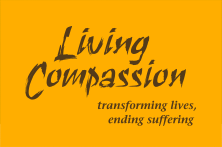Some years ago, I visited the Martin Luther King, Jr. memorial in Atlanta. It was an early weekday morning and the only people there were the security guard and me. I walked contemplatively around the King Center grounds and reflecting pool, thinking about the impact he made on this country and how he died. Noticing a candy wrapper floating in the water, I instinctively picked it up and threw it in the trash. Shortly afterward, the guard approached me and said, "Ma'am, I know you were just trying to help, but we ask that you not touch the water in the pool." I felt stunned, misunderstood, and confused. I uttered some meek response like, "Oh. I was just...um, okay. Thanks." She smiled at me and went about her business.
What the guard could not see was that, in that moment of "enforcing the guidelines," she'd saved me. Well, to be more precise, she'd played a vital role in my being saved. In pointing out my infraction -- regardless of its good intention -- the conversation in conditioned mind was interrupted and I was brought back Here.
That is what is possible with guidelines and guidance.
Practice has brilliantly captured the principle of guidance and guidelines in this one statement:
In this practice we have many guidelines and only one rule: We will use everything in our experience to see how we cause ourselves to suffer so we can drop that and end suffering.
The guidelines of Practice have two very important benefits: 1) They help us get Here when we are listening to a conversation; and 2) they help us not be lulled into a conversation in the first place.
At the Monastery, there is a guideline to wear indoor shoes in the Dining Hall. The moment I realize I’m wearing my outdoor shoes inside the Dining Hall (or am fortunate enough to receive a note containing that information), I know that I had been unconscious before and can come back Here. Additionally, if I want to step inside the Dining Hall just for a quick look at the message board, I may hear ego say something like, “I’m just going to step inside for a minute, I don’t need to change my shoes. Besides, my shoes are clean, I’ve just wiped them down.” Having a guideline to reference gives us a simple and clear alternative to an ego conversation. Besides, guidelines are practical! When we change shoes before entering the Dining Hall, we keep the dirt outside. It's just the intelligent thing to do. We can be grateful that, through guidelines, Practice mirrors our unconsciousness and takes a stand for our inherent desire to do what is best for all.
The Guide urges us that when we have even the slightest niggling sense that something is off, to ask and get guidance. If it's about a Sangha program, we are encouraged to write into the program. People are often invited to write in to the Guestmaster or to call Open Air. The avenues for guidance are plentiful. The point is to turn to Practice for guidance. Why? Because it will save us from egocentric karmic conditioning self/hate and return us to Love.
Incidentally, by getting out of my head that day at the Martin Luther King, Jr. memorial, I was able to experience the profound inspiration of really being there. If I'd gone with ego's reaction to the guidance I received, I would have spent my time there feeling defensive, angry, or perhaps I would even have left altogether in embarrassment. In my experience, wholeheartedly embracing guidelines and guidance is an essential element of being a professional Awareness Practitioner.
In gasshō,
Rebecca
